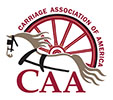 Serial No. 25308
Serial No. 25308Brewster & Co.
New York
1905
Type:
The first Stanhope gig was built about 1816 to a design by the Hon. Fitzroy Stanhope, a noted amateur whip of the day, by J. Tilbury, a carriage builder with a small shop on the Edgeware Road, London. A feature of the design was that the shafts were stiffened throughout their length by a steel plate fitted to the undersides and attached directly to the axle by two turned pillars at each side. The body was suspended by a four-spring combination of two side- and two cross-springs. This combination became known as “Stanhope springs.” The Stanhope fell out of favor in England when lighter gigs, such as the Dennet, were designed, and not many were produced after about 1850. However, in America when horse shows became popular about 1890 and classes for high-stepping “heavy harness horses” (so called to distinguish them from the light harness horses of the American trotter type) were introduced, it was considered appropriate for a gentleman to drive his high-stepper to a gig, and a great many Stanhopes were built by American manufacturers for show driving. Gigs were never adopted for everyday use in the U.S. as they were in Britain.
Provenance:
This Stanhope gig was built by Brewster & Co. of Broome Street to the order of Senator C.W. Watson of Baltimore, who exhibited harness horses at the first International Horse Show at Olympia, London, in 1907 and at other important shows. Later it belonged to Colonel George C. Haas of Mount Kisco, New York, an owner and exhibitor of Hackney horses. Colonel Haas gave it to Mr. Seabrook in May, 1954. It was most recently brush-painted in 1974 by Victor Morgan of London, England, using hand-mixed paint, made with a base of white lead and linseed oil tinted with japan colors. It was finished with imported English pale carriage varnish.
Builder:
Brewster & Co. was founded by Henry Brewster, a son of James Brewster, a noted early-19th-century carriage builder at New Haven. Henry Brewster’s firm was founded in 1856 and was first known as Brewster of Broome Street, New York, but changed the name to Brewster & Co. when its main office was moved to Broadway and 47th Street in 1874. Under the direction of John W. Britton, one of the partners in the firm, Brewster & Co. became the leading builder of high-class carriages in the U.S., and enjoyed the custom of most of the prominent personalities in New York society and elsewhere.
